

Lorem ipsum dolor sit amet, consectetur adipiscing elit ut liqua purus sit amet luctus venenatis, lectus magna.

While doubles often gets the spotlight in pickleball, singles play brings its own unique pace and strategy. Nowhere is that more apparent than in the serve. If you’re stepping onto the court for a one-on-one match, knowing the rules for singles serving can give you a strong start—and a real edge.
Let’s walk through the essential serving rules for singles pickleball, along with how they differ from doubles.
Just like in doubles, the serve in singles must be made underhand, with the paddle striking the ball below the waist. At least one foot must remain behind the baseline until contact is made, and the ball must be hit diagonally across the court into the receiver’s service area.
These foundational rules ensure fair play and consistent form, whether in casual games or competitive tournaments.
In singles, players don’t rotate sides with a partner—but they do rotate court positions based on their score.
This rotation ensures both players get equal exposure to forehand and backhand returns and keeps play fair throughout the match.
Only the server can earn points, and matches are typically played to 11 or 15 points, win by 2. When the server wins a rally, they score a point and switch sides (from right to left or vice versa) to serve the next point.
If the server loses the rally, it's a side-out, and the opponent takes over serving. Unlike doubles, where two players per team serve before a side-out, singles is straightforward: one player serves at a time, and possession switches after each lost point.
In doubles play, servers are labeled “1” or “2” to help track turns. In singles, this designation isn’t necessary. There’s only one server per side, so score announcements are simplified to just two numbers: the server’s score followed by the receiver’s score.
For example, a call of “5-3” means the server has five points and the receiver has three.
Singles serving in pickleball is about more than just putting the ball in play—it’s also a strategic opportunity. Because players have to cover the entire court alone, the placement of the serve can make a big difference. A deep serve to the backhand or a low, angled serve can force your opponent off balance from the start.
After the serve, players must be prepared to cover more ground than in doubles, making stamina, footwork, and shot placement even more important.
Even seasoned players occasionally trip up on singles serving rules. Here are a few of the most common pitfalls:
Remaining mindful of these details keeps rallies clean and avoids unnecessary faults.
Singles pickleball serving may seem simple on the surface, but it plays a major role in match momentum. Unlike doubles, where teamwork affects every rally, singles puts the full weight of play—and positioning—on one player.
Mastering the serve, understanding court rotation, and anticipating your opponent’s return all help you stay in control from the very first shot. Whether you're entering your first singles match or refining your game, knowing the serving rules is a solid step toward better performance.


Explore our collection of 200+ Premium Webflow Templates